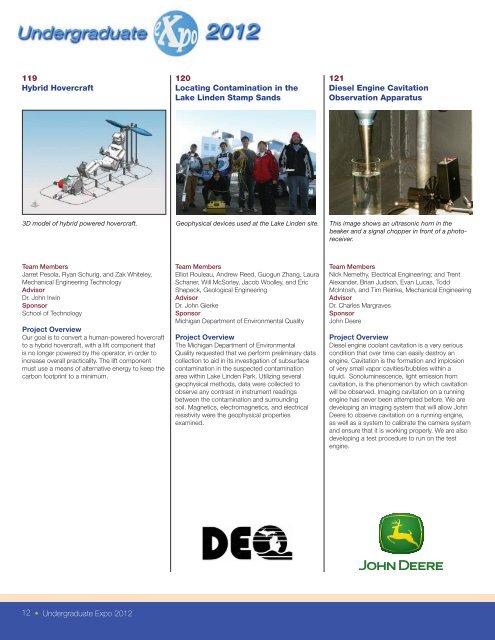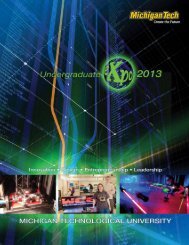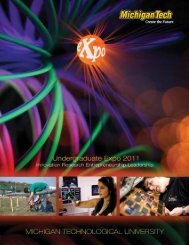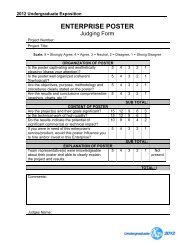Download - Undergraduate Expo - Michigan Technological University
Download - Undergraduate Expo - Michigan Technological University
Download - Undergraduate Expo - Michigan Technological University
You also want an ePaper? Increase the reach of your titles
YUMPU automatically turns print PDFs into web optimized ePapers that Google loves.
119<br />
Hybrid Hovercraft<br />
120<br />
Locating Contamination in the<br />
Lake Linden Stamp Sands<br />
121<br />
Diesel Engine Cavitation<br />
Observation Apparatus<br />
3D model of hybrid powered hovercraft. Geophysical devices used at the Lake Linden site. This image shows an ultrasonic horn in the<br />
beaker and a signal chopper in front of a photoreceiver.<br />
Team Members<br />
Jarret Pesola, Ryan Schurig, and Zak Whiteley,<br />
Mechanical Engineering Technology<br />
Advisor<br />
Dr. John Irwin<br />
Sponsor<br />
School of Technology<br />
Project Overview<br />
Our goal is to convert a human-powered hovercraft<br />
to a hybrid hovercraft, with a lift component that<br />
is no longer powered by the operator, in order to<br />
increase overall practicality. The lift component<br />
must use a means of alternative energy to keep the<br />
carbon footprint to a minimum.<br />
Team Members<br />
Elliot Rouleau, Andrew Reed, Guogun Zhang, Laura<br />
Schaner, Will McSorley, Jacob Woolley, and Eric<br />
Shepeck, Geological Engineering<br />
Advisor<br />
Dr. John Gierke<br />
Sponsor<br />
<strong>Michigan</strong> Department of Environmental Quality<br />
Project Overview<br />
The <strong>Michigan</strong> Department of Environmental<br />
Quality requested that we perform preliminary data<br />
collection to aid in its investigation of subsurface<br />
contamination in the suspected contamination<br />
area within Lake Linden Park. Utilizing several<br />
geophysical methods, data were collected to<br />
observe any contrast in instrument readings<br />
between the contamination and surrounding<br />
soil. Magnetics, electromagnetics, and electrical<br />
resistivity were the geophysical properties<br />
examined.<br />
Team Members<br />
Nick Nemethy, Electrical Engineering; and Trent<br />
Alexander, Brian Judson, Evan Lucas, Todd<br />
McIntosh, and Tim Reinke, Mechanical Engineering<br />
Advisor<br />
Dr. Charles Margraves<br />
Sponsor<br />
John Deere<br />
Project Overview<br />
Diesel engine coolant cavitation is a very serious<br />
condition that over time can easily destroy an<br />
engine. Cavitation is the formation and implosion<br />
of very small vapor cavities/bubbles within a<br />
liquid. Sonoluminescence, light emission from<br />
cavitation, is the phenomenon by which cavitation<br />
will be observed. Imaging cavitation on a running<br />
engine has never been attempted before. We are<br />
developing an imaging system that will allow John<br />
Deere to observe cavitation on a running engine,<br />
as well as a system to calibrate the camera system<br />
and ensure that it is working properly. We are also<br />
developing a test procedure to run on the test<br />
engine.<br />
12 • <strong>Undergraduate</strong> <strong>Expo</strong> 2012






